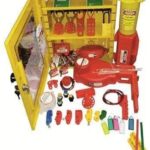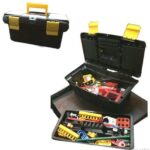Your list is empty, add products to the list to send a request
How Fire Alarm System Work: A Complete Guide to Fire Safety Technology

06
Aug
Whether you’re managing a commercial building, a residential property, or an industrial facility, fire safety is non-negotiable. One of the most vital systems for early detection and prevention is the fire alarm system. But have you ever stopped to ask, “How fire alarm system work?”
In this comprehensive blog, you’ll get a complete breakdown of how these systems operate, their core components, and why modern addressable panels like the TNA Intelligent Addressable Fire Alarm Control Panel offer advanced safety features that can make all the difference in an emergency.
What Is a Fire Alarm System?
A fire alarm system is a network of interconnected devices designed to detect fire, alert building occupants, and initiate emergency procedures. It works by sensing smoke, heat, or flame, and immediately triggers alerts through visual and audio signals such as alarms, flashing lights, or voice evacuation messages.
Modern systems go beyond just ringing an alarm—they can notify emergency services, shut down air handling units, and even activate sprinklers.
How Fire Alarm System Work Step by Step
To answer the question “how fire alarm system work”, here’s a clear, step-by-step breakdown:
Step 1: Detection
Sensors detect the presence of smoke, excessive heat, or flame.
Step 2: Signal Transmission
Once a threat is detected, the sensor sends a signal to the fire alarm control panel.
Step 3: Assessment
The control panel analyses the data. In intelligent systems, it verifies the signal to reduce false alarms.
Step 4: Alert Activation
If a real threat is confirmed, alarms (sounders, strobes, or voice systems) are activated to alert occupants.
Step 5: Response Integration
In some systems, fire alarms automatically notify emergency services, activate suppression systems, or control building management systems like ventilation.
What Are the Three Basic Components of a Fire Alarm System?
A functioning fire alarm system relies on three key components:
1. Detection Devices
These include:
- Smoke detectors
- Heat detectors
- Flame detectors
- Manual call points (MCPs)
2. Control Panel
This is the brain of the system. The TNA Intelligent Addressable Fire Alarm Control Panel is a great example. It receives input, interprets it, and issues commands for alarms or other actions.
3. Notification Devices
These devices alert people in the building:
- Sounders (alarms)
- Visual strobes
- Voice alert systems
Some systems also include emergency lighting and automatic door releases.
How Intelligent Fire Alarm Systems Improve Performance
Conventional systems typically divide buildings into zones and can only tell you where the fire might be. In contrast, addressable systems, like the TNA panel, assign a unique address to each device.
Benefits include:
- Pinpoint accuracy of the activated device
- Remote monitoring and control
- Digital records for inspection and maintenance
- Reduced false alarms
How to Reset a Fire Alarm Panel
Once a fire event or false alarm has been resolved, the panel needs to be reset. Here’s a basic guide to resetting most addressable systems:
- Acknowledge the Alarm
Press the “Silence” or “Acknowledge” button to stop alerts. - Investigate the Triggered Device
Check which detector or zone was activated. - Clear the Threat
Ensure smoke, heat, or other triggers are resolved. - Reset the Panel
Use the “Reset” button. You may need a key or passcode depending on the model.
If issues persist, the panel may show a fault—this typically means something hasn’t been resolved or a device needs maintenance.
Common Fire Alarm System Types
Here’s a quick overview of fire alarm system categories:
Conventional Systems
- Divide the building into zones
- Good for smaller buildings
Addressable Systems
- Devices have unique digital addresses
- Ideal for large, complex buildings
Wireless Fire Alarms
- Useful for buildings where running cables is difficult
Hybrid Systems
- Combine wired and wireless devices for flexibility
Features of TNA Intelligent Addressable Fire Alarm Control Panel
Looking for a high-performing system? The TNA Fire Alarm Panel comes loaded with advanced features:
- LCD screen with system status
- Event logs for audits
- Multi-zone configuration
- Custom alerts by room or device
- Battery backup support
- Expandable device loops
Perfect for hospitals, malls, factories, data centres, schools, and more.
Benefits of Understanding How Fire Alarm System Work
- Quicker Response: Knowing how your system works allows faster, smarter decision-making during emergencies.
- Effective Maintenance: Spot problems early and resolve them before they affect performance.
- Cost Savings: Address issues without relying solely on external technicians.
- Compliance: Stay aligned with fire safety standards and audits.
Maintenance Checklist for Fire Alarm Systems
Weekly
- Visually inspect the control panel
- Confirm system power and connections
Monthly
- Test manual call points and detection devices
- Reset the panel and confirm functionality
Annually
- Full inspection by a certified technician
- Clean detectors and update software/firmware
Frequently Asked Questions
1. How does a fire alarm system work step by step?
A fire alarm system detects a hazard through sensors, sends a signal to the control panel, which then triggers alerts (sirens, strobes, etc.) and may notify emergency services. Modern systems also record events and can activate other safety measures like ventilation or sprinklers.
2. What are the three basic components of a fire alarm system?
- Detection devices: Smoke, heat, or flame sensors
- Control panel: Central unit that receives and processes signals
- Notification devices: Alarms, strobes, or voice alerts
3. How to reset fire alarm panel?
After clearing the hazard, press the “Reset” button on the panel. You may need a password or access key. Ensure all detectors are clear and no faults remain. Refer to the manufacturer manual or consult a technician if issues persist.
Final Thoughts
Fire alarm systems save lives. But they do more than just sound an alert—they give you the precious seconds you need to act. Understanding how fire alarm system work empowers you to better manage safety, respond faster, and stay compliant.
Whether you’re planning an installation or an upgrade, consider investing in smart, addressable systems like the TNA Intelligent Addressable Fire Alarm Control Panel.
Ready to Upgrade Your Fire Safety?
Explore the Fire Alarm Panel and give your property the intelligent protection it deserves.
Early detection saves lives—make it count.


























